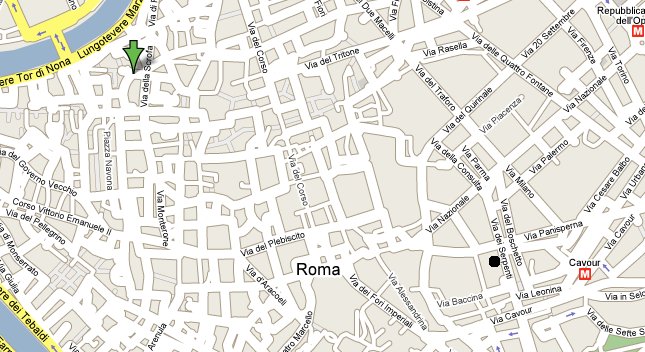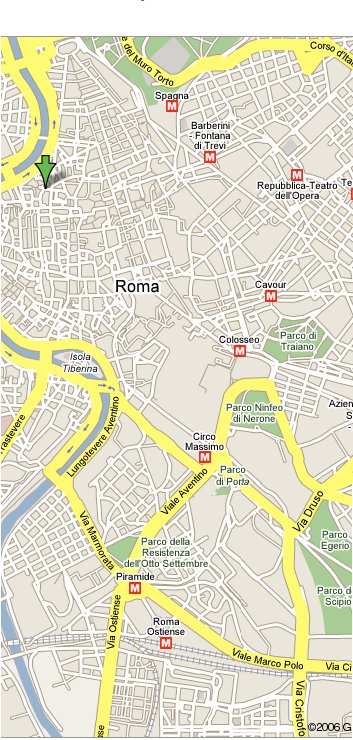Rome Sightseeing Notes
Introduction
This is a web page made up of my notes from researching a trip to Rome
in the spring of 2007.
Rome is a daunting city. Rome has some of the oldest and best
preserved ruins and Imperial era buildings in the western world. In
addition to this there are churches from the Gothic, Byzantine and
Renaissance eras. There are unique and beautiful gardens, piazza and
buildings. The only way to truely see Rome would be to live there for
an extended period of time. For a short visit of a week the
possibilities can be overwhelming.
The Vatican Museum
The Vatican Museum, which includes the Sistine Chapel, has changed
it's hours as of January 2007. General admission hours start at
10:00. Tours and reserved tickets allow people to get in at 8:30.
One web site where tickets can be purchased is:
-
Rome Museum (part of the tuscanyall.com tour company)
Advance tickets, allowing 8:30 entry can be purchased from this web
site for 23 Euros per adult. They email you a voucher that you take to
the Vatican before your visiting time. There is someone there with a
sign with the travel company logo. They exchange the voucher for a
ticket and then you can enter do early entry at the Vatican Museum.
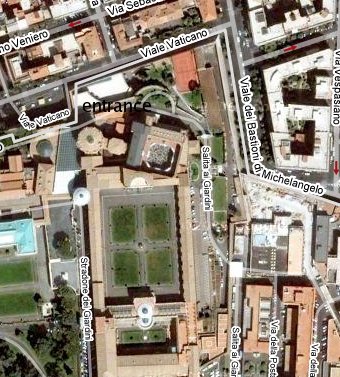
Guided Tours
In general I have a bias against tours. Exploring a city on your own
leads to surprising discovery. It also forces you to interact more
with the local people, in the local language, so you get more of a
feel for the country. Rome is a daunting city however. I will only
be in Rome for seven full days, which means that I will only be able
to scratch the surface of this ancient city.
-
Context Tours: Rome
Context Tours/Travel seems to be geared to the educated tourist.
Their guides are well educated and they concentrate on seeing a
destination in depth, rather than seeing many sites.
Most of the Context Tours last four to five hours. The prices seem
reasonable and the groups are small (six people or so). Context
Travel seems to choose guides who are well educated, not just people
who are fluent in english.
So far I'm doing two Context Travel events/tours: the Italian
Language Workshop and the Ostia Antica Excursion.
The thing that I hate the most about travel is getting from place to
place. Taking the train and then a bus from Venice to Siena was a
nerve wracking experience (I had a hard time finding my bus at the
Florence train station). From Siena to Bologna my train was late and
I was worried about missing my connecting train in Florence.
I want to see the ancient port of Rome, Ostia Antica which is outside
of the city. A tour not only is attractive because they will help me
get from place to place but also because the guides are knowledgeable.
I also decided to sign up for an hour and a half Italian language
seminar the day after I arrive in Rome. I have taken two beginning
conversational Italian courses and I hope that seminar will get me
back into speaking a bit of Italian.
As I note above, I do plan to visit the Vatican Museum and the
Basilica of Saint Peter. But my main interest is in the classical
Imperial era. My notes reflect this.
The Pantheon
Open: 8:30 AM to 7:30 PM Mon-Sat, 9 AM to 6 PM on Sun
The Pantheon is one of the most remarkable buildings remaining from
the classical Imperial era of Rome. The Pantheon was constructed from
118-125 AD by emperor Hadrian. The dome built from concrete and
masonry. The Pantheon has remained standing all these centuries in
the faces of invaders and Christianity in no small part because of its
massive walls.

Image from Google Maps
Ara Pacis and the Mausoleum of Augustus
According to my Eyewitness Travel Guide Rome the Mausoleum of
Augustus is an unimpressive ruin these days. However, near the
Mausoleum is the Ara Pacis the Altar of Peace which has some
beautiful friezes. Apparently the Ara Pacis is housed in a
controversial building designed by the architect Richard Meier who
designed the Barcelona
Museum of Contemporary Art.
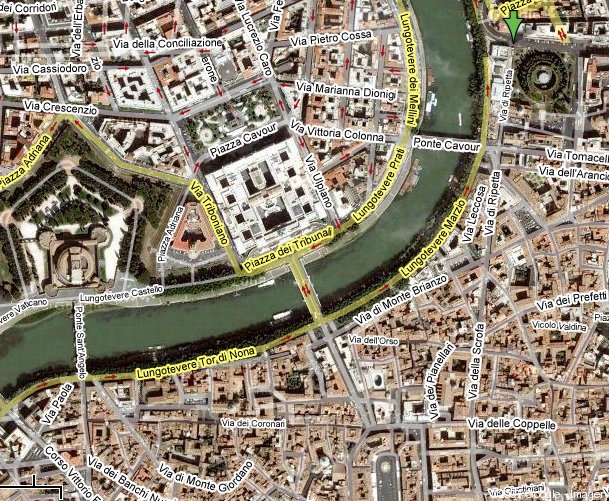
Ara Pacis and the Mausoleum of Augustus are in the upper right corner
of the map.
Image from Google Maps
The Roman Forum
Entrances:
- Largo Romolo e Remo
- Via del Foro Romano
- Near the Arch of Titus on Via Sacra
Open 9:00 AM to 1 hour before sunset daily, last admission 1 hour
before closing.
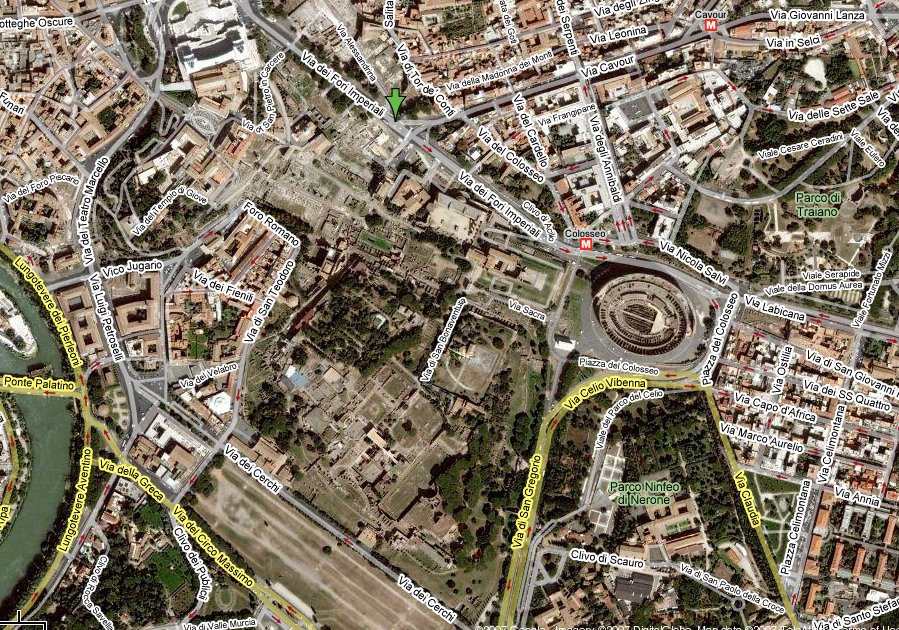
Image from Google Maps
Palatine
Open: 9:00 to one hour before sunset. The last admission is one hour
before closing. Apparently the entry fee for the Palatine includes
the Colosseum as well.
The Palatine hill was the high rent area of Rome during the classical
era. Augustus and his wife Livia had houses there, as did Cicero.
Ruins of the House of Augustus and Livia survive. The entrance to the
Farnese botanical gardens are at the north end of the Palatine.
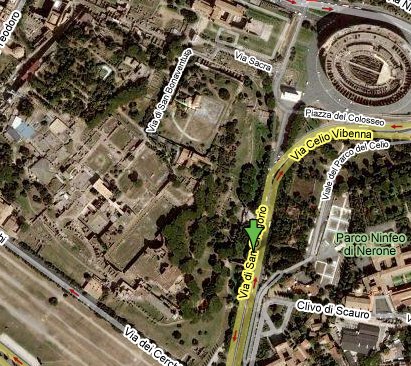
Image from Google Maps
Trajan's Markets (Mercati Traianei)
Trajan's Markets are located near the North West corner of the Roman
Forum. The entrance is off of Via 4 Novembre Comune, near the Piazza
Venezia.
Open 9:00 AM to 4:30 PM Tue-Sun
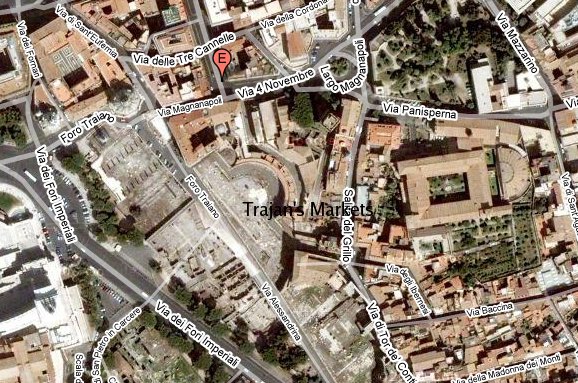
Image from Google Maps
The last of the Imperial fora to be built, the vast Forum of Trajan,
was entered through a triumphal arch in the Forum of Augustus, an area
which it imitated in various ways. Immediately inside this arch was
an enormous plaza surrounded by the traditional portico and with deep
exedrae bulging out on either side. An equestrian statue of the
emperor, who ruled from 98 to 117 AD, stood in its center, and its
buildings included a temple to the deified emperor. Behind this plaza
stood the Basilica Alias, a five-aisled structure with twin apses,
which like the basilicas of the Roman Forum, carried its roof on
parallel rows of marble columns,many of which are still visible. On
the far side of the basilica two libraries flanked the Column of
Trajan. General business was conducted in the basilica, where on
atrium was dedicated entirely to ceremonies for the manumission of
slaves. Its libraries held public records. Readings and lectures on
literature were held in the exedrae. This forum, distinguished in
scale from the others, is similar in its political symbolism. Like
the Forum of Vespasian, it celebrates peace while it commemorates a
significant victory. Much of the sculptural decoration referred to
the emperor's war in Dacia (modern Romania), and the official history
of that campaign scrolls up the emperor's column in bas-relief. The4
defied emperor was buried at its base.
The conservative architecture of Trajan's Forum had no place in the
commercial buildings behind it. Instead, the creators of Trajan's
Market were free to work in the materials and style of the Roman
architectural revolution. The wonderful and imaginative complex
responds to structural and social problems created by the Forum of
Trajan. It replaces commercial space that may have been eliminated
and acts as a retaining wall to shore up the slopes of the Quirinal
hill that were cut into as the forum was built. The rooms at its base
are arranged in a semicircle that responds to the exedra on the forum.
Rome from the Ground Up by James H.S. McGregor, 2005
The Tempietto
Open: 9:30 AM to 12:30 PM, 2:00 PM to 4:00 PM
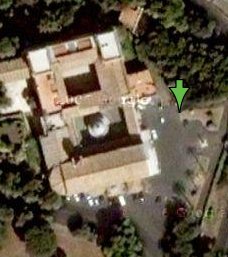
Image from Google Maps
Elsewhere in Rome, Bramante himself created an unusual shrine in this
style which gives some idea of his conception of St. Peter's. In a
cramped cloister next to the church of San Pietro in Montorio,
Bramante erected a tiny monument that served as the epitome of High
Renaissance aesthetic. Called the Tempietto, it stands on the spot
where a secondary medieval tradition located the martyrdom of
St. Peter. Circular in form like the martyr shrines Santa Costanza
and Santo Stefano Rotondo, the Tempietto would have stood in a round
courtyard with a loggia, had Bramante's plan been carried out. The
oppressive square courtyard in which the temple now stands bears no
relation to what he intended. Despite its cramped setting, this
wonderful building proved to Bramante's contemporaries that the
grammar of Roman architecture could be used to produce novel and
beautiful results. This is no slavish recreation of a classical
prototype but an entirely new structure in an ancient idiom. While it
is similar to the round temple in the Forum Boarium, Bramante's
structure divides an equivalent vertical space into two zones. This
characteristic of his style improves the proportions of the colonnade
and frame the small cupola, which is raised on a drum, behind the
entablature and balcony in a way that makes it appear higher than it
really is. Stairs in the back of the monument lead down to a crypt
decorated with a remarkable stucco work.
Rome from the Ground Up by James H.S. McGregor, 2005
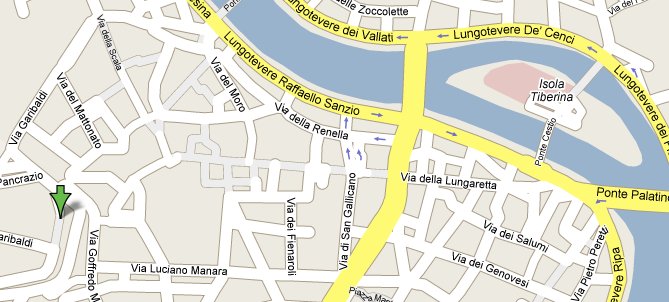

Image from Google Maps


